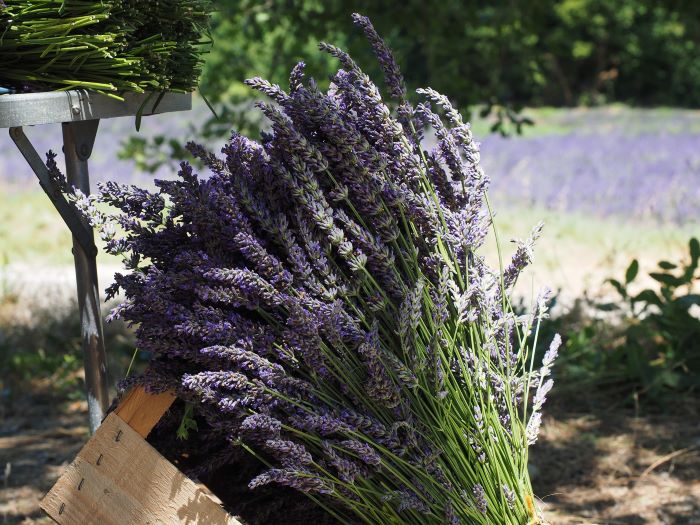Lavender is a plant most everyone loves. Whether it’s the purple flowers, the fragrance, or even the images of a lavender harvest in French lavender fields, lavender is a loved plant.
It’s also a great landscape plant for us in dry summer regions. It’s an excellent choice for low water landscaping and it prefers soils of low fertility.
It’s deer resistant. And it’s a feast for many, many pollinators!
So it’s a high benefit, low maintenance plant overall.
Except, it needs proper pruning to look its very best, and that may even give you a second round of flowers.
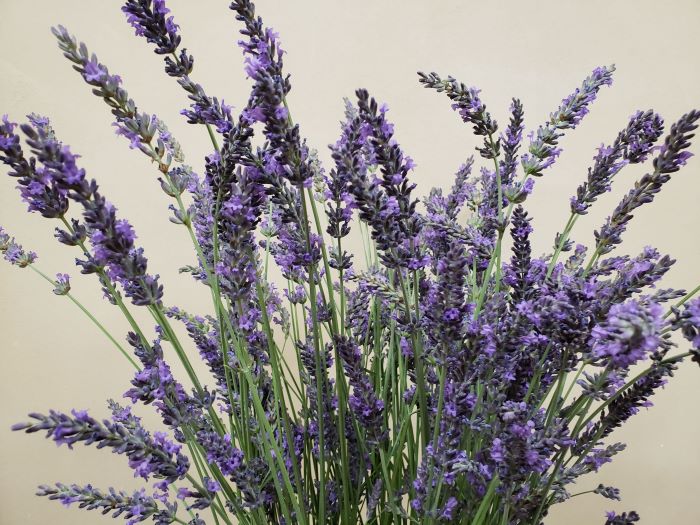
Does your lavender get the summer uglies?
I see so many lavender plants that don’t get proper pruning and that makes them ugly from mid-summer through till a late winter pruning. These plants could be maintained to stay beautiful as a landscape plant and could even promote more flowering. But timing is important.
Pruning twice a year pays off in a nicely shaped landscape asset.
The lavender types I’m talking about here are the English lavenders (Lavandula angustigolia) and the French hybrid lavenders (Lavandula x intermedia). The English include ‘Munstead’ and ‘Hidcote’ and the French hybrids include ‘Provence’ and ‘Grosso’ (my favorite). Both types have taller, upright flower stems. The French hybrids are often larger plants. I’m not talking about Spanish lavender—that’s a different animal.
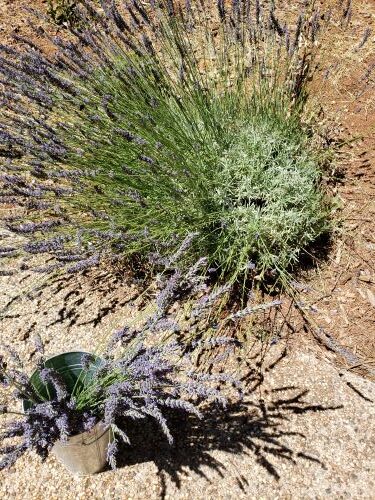
The harvest pruning
Harvesting the flowers during or soon after bloom will be your first pruning. Exactly when you harvest them will depend on what you may like to do with your flowers. I’ll discuss those options below in Harvesting the Flowers.
Here’s how to harvest. Grab a bundle and cut them at the bottom of the stems. Get all the flowers. My tool for flower cutting is a good pair of Felco #2 clippers (they’re the best). Cut just below where the stems rise above the foliage.
If the plant looks ragged at the end, even it up with hedging shears, all around the plant. (I’ll discuss more on planting a hedge below.) My tool of choice is manual hedging shears. I think they give a cleaner cut. Don’t leave flower stem stubble but don’t cut too far into the foliage below.
Any flowers you can’t use can go into the compost.
What you’ll have is a sheared lavender, looking a little raw on the edge, maybe with some yellowed leaves. But it will grow back nicely, and the plant will have a nice shape. And you may get some more flowers, though fewer of them.
If you don’t do this, the stems dry up and look dead later in the summer. It’s not attractive! And, if your lavender does put out a second round of flowers, they’ll be mixed in with dead stems and difficult to cut for a bouquet.
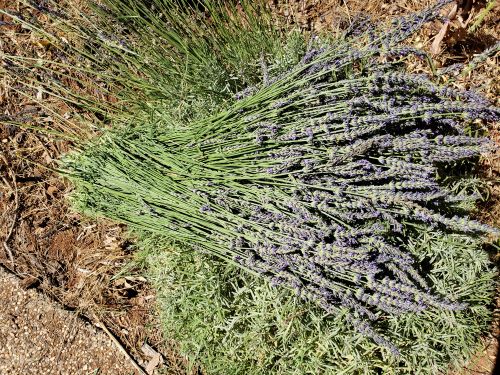
Harvest prune before the bloom on the flower stalks is completely open. The earlier you do it, the greater your chance of producing a second bloom. One that’s harvestable. And with more food for the bees through the summer.
The winter pruning
This pruning can happen in late fall to late winter. It goes a little deeper and helps shape the plant. This time cut a little further into the shrub, about an inch or so, but not into the wood. Deep cuts into lavender wood don’t recover well.
If your plant is new, you can allow it to get to its normal height with a lighter pruning or you can keep it to a smaller height by pruning it a little deeper to maintain the desired height each year. This is what they do to make knot gardens. But it doesn’t work to reduce a larger plant to a smaller one.
In the spring you’ll have your next big flush of flowers.
Here are some tips on harvesting lavender to get the most enjoyment out of your plants.
Harvesting the flowers
With one or a couple of mature lavender plants you’ll have plenty of fresh flowers, maybe too many. That means you can harvest them for dried use for culinary and herbal uses, for fresh flower use, and for dried flowers on the stem. Each purpose has a different time of harvest.
1. Dried flower buds: For dried flower buds to use for herbal and culinary use and for sachets and potpourris, harvest just as the first 2 or 3 buds open and there is color in all the buds. This way you’ll capture the buds at peak oil content, which is what you’re after.
The stems will wilt at this point so tie them up in bundles and hang in a dry, darkish, airy spot. Or lay on a screen in the same place. I’ve often used simple nursery flats for a screen to lay them in. Give them good air circulation.
2. Fresh use: Fresh cut lavender adds nice fragrance and color to bouquets. Harvest any time when the buds are opening. This is when the stems are thicker and will hold up well.
3. Dried flowers: For dried floral arrangements lavender can add fragrance, form and color to arrangements. I find it’s best to harvest when many of the flower buds have opened. This is when the stem is thickest and strongest at the tip and it makes the flower able to stand up when it’s dry. So, you can cut the flowers and place straight in a vase, no water, and let them dry there.
Plant a hedge of lavender
If you want a lavender hedge, plant the plants closer together. Plant with a six inch overlap of their mature width. That means to plant a ‘Grossso’ lavender hedge, and ‘Grosso’ gets up to 36 inches wide, you’d plant them 30 inches apart, measuring from the centers. You can opt for planting them 28 inches apart to fill in more quickly.
To prune your hedge, skip the deeper planting on the inside edges between the plants. This will let them grow together and overlap for a hedge.
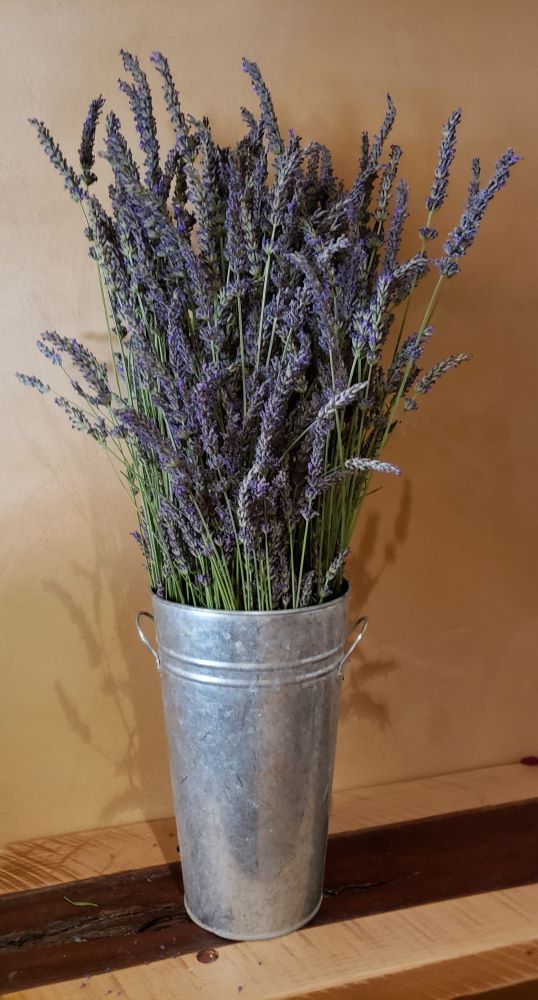
What about the bees?
Bees are one of the wonderful things about lavender. It attracts many of them and many kinds of bees, especially the native bees which are powerhouse pollinators.
But I’m asking you to keep your landscape lavender plants harvested at the right times, when they are in flower. So there will be bees.
First of all, I have harvested lots and lots of lavender full of buzzing busy bees and I have never gotten stung by them. The native bees, especially, are not at all aggressive. They’re all so busy and happy that they don’t notice or care that you’re cutting the flowers.
But, if you’re allergic to bee stings then you want to take precautions. So you can harvest early in the morning or late in the evening when bee activity is quiet. Or, have someone else do it for you.
And if you want to keep the flowers for the bees, harvest prune when activity is lower. Don’t wait too long.
So, please, harvest your lavender during bloom or at least immediately after. Those fading, drying flowers and stems on the plant do not look good, trust me. What does look good is a nicely shaped lavender plant with some new growth and new flowers coming out through the rest of the summer and fall.
Other Topics You May Like
How Much Sun Does Your Plant Need?
Should You Use Pruning Sealer?
How to Boost the Beneficial Insects in Your Landscape and Garden
Planting Flowers for Bees? Avoid the Flowers with This Pesticide

